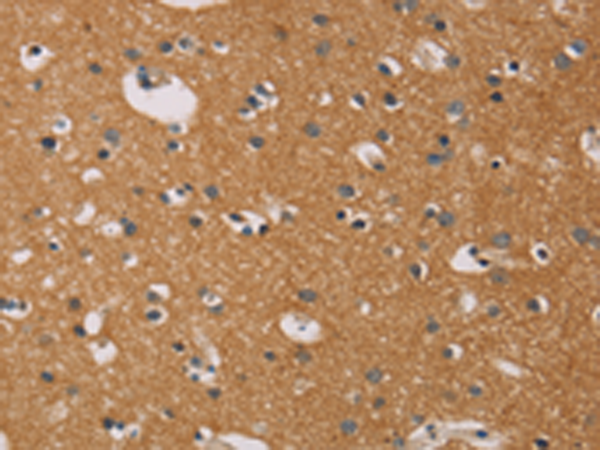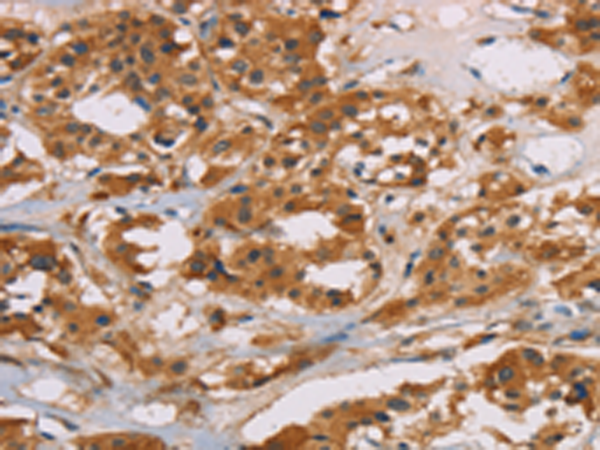

| WB | 咨询技术 | Human,Mouse,Rat |
| IF | 咨询技术 | Human,Mouse,Rat |
| IHC | 1/50-1/200 | Human,Mouse,Rat |
| ICC | 技术咨询 | Human,Mouse,Rat |
| FCM | 咨询技术 | Human,Mouse,Rat |
| Elisa | 1/2000-1/5000 | Human,Mouse,Rat |
| Aliases | SIGLEC2; SIGLEC-2 |
| Host/Isotype | Rabbit IgG |
| Antibody Type | Primary antibody |
| Storage | Store at 4°C short term. Aliquot and store at -20°C long term. Avoid freeze/thaw cycles. |
| Species Reactivity | Human |
| Immunogen | Fusion protein of human CD22 |
| Formulation | Purified antibody in PBS with 0.05% sodium azide and 50% glycerol. |
+ +
以下是3-4条关于CD22抗体的参考文献及其简要摘要:
---
1. **文献名称**:*Inotuzumab Ozogamicin versus Standard Therapy for Acute Lymphoblastic Leukemia*
**作者**:Shah, N.N., et al.
**摘要**:该研究报道了抗CD22抗体偶联药物Inotuzumab Ozogamicin在复发/难治性急性淋巴细胞白血病(ALL)患者中的III期临床试验结果,显示其较标准化疗显著提高完全缓解率并延长无进展生存期。
2. **文献名称**:*CD22: A Regulator of Innate and Adaptive B Cell Responses and Autoimmunity*
**作者**:Tedder, T.F., et al.
**摘要**:这篇综述系统总结了CD22作为B细胞表面抑制性受体的分子结构与功能,探讨其在B细胞信号调控、自身免疫性疾病中的作用,以及靶向CD22的治疗策略开发潜力。
3. **文献名称**:*Antibody-Targeted Chemotherapy with Anti-CD22 Antibody–Drug Conjugates Shows Efficacy in Models of B-Cell Lymphoma*
**作者**:Dijoseph, J.F., et al.
**摘要**:通过临床前研究验证了抗CD22抗体与细胞毒性药物(如卡奇霉素)偶联的疗效,证明其在B细胞淋巴瘤模型中显著抑制肿瘤生长并延长生存期,为后续临床试验奠定基础。
4. **文献名称**:*Targeting CD19 and CD22 with Bispecific Antibodies in B-Cell Malignancies*
**作者**:Topp, M.S., et al.
**摘要**:研究开发了一种同时靶向CD19和CD22的双特异性抗体,用于治疗难治性B细胞恶性肿瘤,早期临床试验显示其安全性及初步抗肿瘤活性,提示双靶向策略的潜在优势。
---
以上文献涵盖基础机制、抗体偶联药物开发及临床治疗应用,反映了CD22抗体在肿瘤免疫治疗中的关键进展。
CD22. a transmembrane glycoprotein primarily expressed on B cells, serves as a inhibitory coreceptor that modulates B cell receptor (BCR) signaling. Belonging to the sialic acid-binding immunoglobulin-like lectin (siglec) family, it regulates B cell activation, survival, and interaction with the immune microenvironment. Its restricted expression on mature B cells, coupled with overexpression in B-cell malignancies like non-Hodgkin’s lymphoma (NHL) and acute lymphoblastic leukemia (ALL), positions CD22 as a therapeutic target.
CD22-directed antibodies emerged in the 1990s, with early efforts focusing on naked monoclonal antibodies (e.g., epratuzumab) to induce antibody-dependent cellular cytotoxicity (ADCC) or apoptosis. However, limited efficacy in clinical trials spurred advanced strategies. Antibody-drug conjugates (ADCs), such as inotuzumab ozogamicin (linking anti-CD22 to calicheamicin), demonstrated improved outcomes in relapsed/refractory ALL by delivering cytotoxic payloads directly to malignant cells. Bispecific antibodies and CAR-T therapies targeting CD22 are also under investigation, particularly for CD19-negative relapses.
Despite progress, challenges persist, including antigen escape (CD22 downregulation), on-target/off-tumor toxicity, and variable antigen density. Ongoing research explores combination therapies, novel epitope targeting, and engineered antibodies with enhanced pharmacokinetics. CD22 remains a pivotal focus in B-cell malignancy immunotherapy, reflecting its dual role as a signaling modulator and lineage-specific antigen.
×